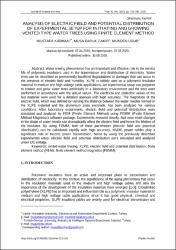Analysis of electric field and potential distribution of experimental setup for initiating and growing vented type water trees using finite element method
Abstract
Water treeing phenomenon has an important and effective role in the service life of polymeric insulators used in the transmission and distribution of electricity. Water trees can be described as permanently localized degradations or damages that can occur in the presence of electric field and humidity. XLPE is widely used as a polymeric insulator material in medium and high voltage cable applications. An experimental setup was prepared to initiate and grow water trees artificially in a laboratory environment and the tests were performed in accordance with the actual values. The electrical and dielectric values of the test material were used for a detailed analysis with high accuracy. The magnitude of the electric field, which was defined by varying the distance between the water needles formed in the XLPE material and the aluminium plate electrode, has been analyzed for various conditions. After laboratory experiments, electric field and potential distribution were simulated and analyzed by FEM (Finite Element Method) using FEMM (Finite Element Method Magnetics) software package. Experiments revealed clearly, that even small changes in the shape of water needle can dramatically affect the electric field and hence the lifetime of the insulator. By using FEMM, both of these parameters (electric field and potential distribution) can be calculated rapidly with high accuracy. HVDC power cables play a significant role in electric power transmission, hence by using the previously described experimental setup, electric field and potential distribution were simulated and analyzed under DC voltage.

















